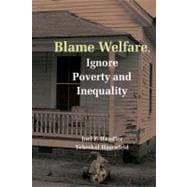
What is included with this book?
| Acknowledgments | ix | ||||
| List of Acronyms | xi | ||||
| 1 Introduction | 1 | (16) | |||
|
5 | (2) | |||
|
7 | (10) | |||
| 2 The State of Poverty: TANF Recipients | 17 | (53) | |||
|
17 | (2) | |||
|
19 | (4) | |||
|
23 | (2) | |||
|
25 | (5) | |||
|
30 | (17) | |||
|
30 | (3) | |||
|
33 | (6) | |||
|
39 | (3) | |||
|
42 | (5) | |||
|
47 | (6) | |||
|
53 | (14) | |||
|
53 | (2) | |||
|
55 | (2) | |||
|
57 | (1) | |||
|
58 | (1) | |||
|
59 | (1) | |||
|
59 | (2) | |||
|
61 | (1) | |||
|
62 | (1) | |||
|
63 | (4) | |||
|
67 | (3) | |||
| 3 The Response to Poverty and Inequality: The Welfare State | 70 | (80) | |||
|
70 | (4) | |||
|
74 | (2) | |||
|
76 | (5) | |||
|
81 | (8) | |||
|
89 | (12) | |||
|
89 | (9) | |||
|
98 | (3) | |||
|
101 | (3) | |||
|
104 | (2) | |||
|
106 | (7) | |||
|
113 | (3) | |||
|
116 | (12) | |||
|
119 | (3) | |||
|
122 | (6) | |||
|
128 | (1) | |||
|
128 | (5) | |||
|
133 | (3) | |||
|
136 | (4) | |||
|
140 | (4) | |||
|
144 | (3) | |||
|
147 | (3) | |||
| 4 Demonizing the Single-Mother Family: The Path to Welfare Reform | 150 | (36) | |||
|
151 | (4) | |||
|
155 | (2) | |||
|
157 | (1) | |||
|
158 | (4) | |||
|
162 | (4) | |||
|
166 | (8) | |||
|
174 | (4) | |||
|
178 | (1) | |||
|
179 | (2) | |||
|
181 | (1) | |||
|
182 | (2) | |||
|
184 | (2) | |||
| 5 The Welfare Bureaucracy | 186 | (52) | |||
|
190 | (1) | |||
|
191 | (4) | |||
|
195 | (2) | |||
|
197 | (2) | |||
|
199 | (4) | |||
|
203 | (3) | |||
|
206 | (2) | |||
|
208 | (8) | |||
|
216 | (3) | |||
|
219 | (14) | |||
|
233 | (2) | |||
|
235 | (3) | |||
| 6 Work and the Low-Wage Labor Market: Mothers and Children | 238 | (44) | |||
|
239 | (7) | |||
|
246 | (5) | |||
|
251 | (2) | |||
|
253 | (1) | |||
|
254 | (2) | |||
|
256 | (1) | |||
|
257 | (1) | |||
|
258 | (2) | |||
|
260 | (4) | |||
|
264 | (2) | |||
|
266 | (7) | |||
|
273 | (2) | |||
|
275 | (3) | |||
|
278 | (2) | |||
|
280 | (2) | |||
| 7 Welfare Reform and Moral Entrepreneurship: Promoting Marriage and Responsible Parenthood and Preventing Teenage Pregnancy | 282 | (34) | |||
|
286 | (3) | |||
|
289 | (1) | |||
|
290 | (5) | |||
|
295 | (3) | |||
|
298 | (3) | |||
|
301 | (2) | |||
|
303 | (2) | |||
|
305 | (1) | |||
|
306 | (1) | |||
|
307 | (3) | |||
|
308 | (1) | |||
|
308 | (1) | |||
|
309 | (1) | |||
|
310 | (1) | |||
|
310 | (1) | |||
|
311 | (3) | |||
|
314 | (2) | |||
| 8 Addressing Poverty and Inequality | 316 | (33) | |||
|
316 | (3) | |||
|
319 | (4) | |||
|
323 | (2) | |||
|
325 | (11) | |||
|
336 | (2) | |||
|
338 | (1) | |||
|
338 | (1) | |||
|
339 | (3) | |||
|
342 | (1) | |||
|
343 | (6) | |||
| References | 349 | (30) | |||
| Author Index | 379 | (3) | |||
| Subject Index | 382 |
The New copy of this book will include any supplemental materials advertised. Please check the title of the book to determine if it should include any access cards, study guides, lab manuals, CDs, etc.
The Used, Rental and eBook copies of this book are not guaranteed to include any supplemental materials. Typically, only the book itself is included. This is true even if the title states it includes any access cards, study guides, lab manuals, CDs, etc.